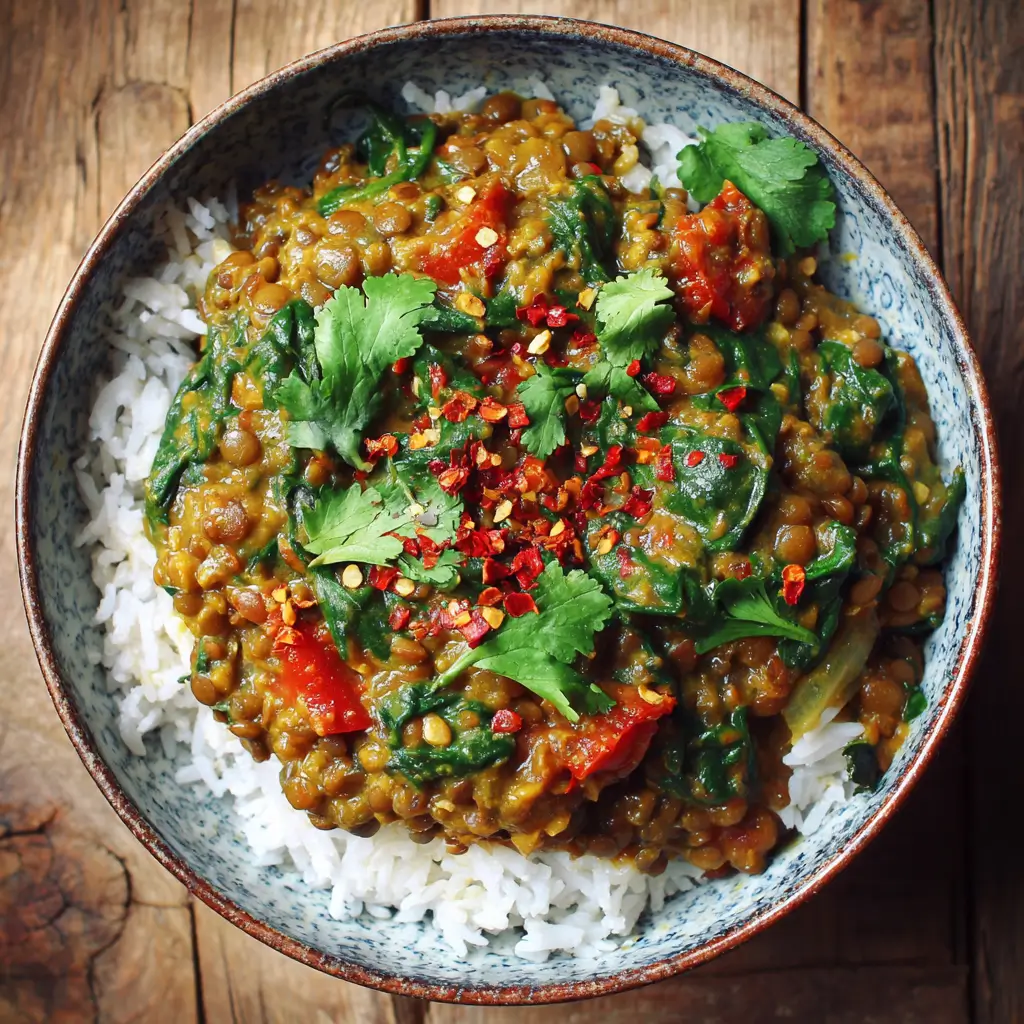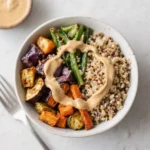Lentil & Spinach Curry: A Hearty, Nutritious Delight
The Lentil & Spinach Curry is a wholesome, aromatic dish that blends the earthy richness of lentils with the vibrant freshness of spinach. Revered across cultures for its nourishing properties and comforting flavor, this curry has become a staple in vegetarian and vegan kitchens worldwide. Packed with protein, fiber, and essential nutrients, it’s not only delicious but also incredibly beneficial for your health. Whether you’re cooking for a family dinner, meal prepping for the week, or exploring plant-based cuisine, this Lentil & Spinach Curry offers a satisfying, flavorful experience that’s easy to make and endlessly customizable.
The History of Lentil & Spinach Curry
Lentils have been a dietary cornerstone for thousands of years, dating back to ancient civilizations in the Mediterranean, South Asia, and the Middle East. Archaeological evidence shows that lentils were cultivated as early as 8000 BCE in regions like modern-day Turkey and Syria. In India, lentils—known as dal—have played a central role in culinary traditions for millennia, often served daily as part of a balanced meal.
Spinach, originally native to Persia (modern-day Iran), made its way into Indian cuisine around the 12th century, where it was embraced for its mild flavor and health benefits. The combination of lentils and spinach likely emerged from regional adaptations in North Indian and Punjabi cooking, where leafy greens are commonly paired with legumes to create nutrient-dense dishes such as palak dal or saag dal.
Over time, this humble yet powerful pairing spread globally through migration, trade, and the popularity of Indian cuisine. Today, Lentil & Spinach Curry is celebrated not just in traditional households but also in health-conscious communities, fusion restaurants, and home kitchens across Europe, North America, and beyond. Its evolution reflects a beautiful blend of history, culture, and nutrition, making it a timeless favorite.
Ingredients Breakdown
The magic of Lentil & Spinach Curry lies in its balance of simple, whole ingredients that come together to form a complex and satisfying flavor profile. Here’s a detailed look at each component:
- Brown or Green Lentils: These hold their shape well during cooking and provide a meaty texture and nutty taste. They’re rich in protein, iron, and fiber.
- Fresh Spinach: Adds color, vitamins (especially A, C, and K), and a slightly sweet, earthy note. Frozen spinach works too, offering convenience without sacrificing nutrition.
- Onion, Garlic, and Ginger: Form the aromatic base of the curry, enhancing depth and warmth. These also offer immune-boosting and anti-inflammatory properties.
- Tomatoes (fresh or canned): Provide acidity and natural sweetness, helping to balance the spices and thicken the sauce.
- Cooking Oil (e.g., coconut, olive, or vegetable): Used to sauté aromatics and help release fat-soluble compounds from spices.
- Spices: Typically include cumin seeds, ground coriander, turmeric, garam masala, red chili powder, and black pepper. Each contributes unique flavors and health benefits—turmeric, for example, contains curcumin, known for its anti-inflammatory effects.
- Vegetable Broth or Water: Serves as the cooking liquid, infusing the lentils with flavor while creating a luscious consistency.
- Bay Leaf and Cinnamon (optional): Add subtle warmth and complexity to the background notes.
- Lemon Juice or Amchur (dry mango powder): A touch of acid brightens the dish and enhances overall flavor.
- Fresh Cilantro (Coriander leaves): Used as garnish, adding a fresh, citrusy finish.
- Coconut Milk (optional): For a creamier, richer version, especially popular in South Indian or Sri Lankan variations.
Step-by-Step Recipe
- Rinse the Lentils: Place 1 cup of brown or green lentils in a fine-mesh strainer. Rinse thoroughly under cold water until the water runs clear. This removes dust and reduces any potential digestive discomfort.
- Soak (Optional): While not required, soaking lentils for 15–30 minutes can reduce cooking time and improve digestibility.
- Sauté Aromatics: Heat 2 tablespoons of oil in a large pot or Dutch oven over medium heat. Add 1 teaspoon of cumin seeds and let them sizzle for 15–20 seconds until fragrant. Add 1 chopped onion and cook for 5–7 minutes until golden brown.
- Add Ginger-Garlic Paste: Stir in 1 tablespoon of ginger-garlic paste (or freshly minced equivalents) and sauté for another minute until the raw smell disappears.
- Incorporate Spices: Add 1 teaspoon ground coriander, ½ teaspoon turmeric, ½ teaspoon red chili powder, and ½ teaspoon garam masala. Stir quickly for 20–30 seconds to toast the spices, releasing their essential oils.
- Add Tomatoes: Mix in 1 cup of chopped tomatoes (or ½ can of diced tomatoes). Cook for 5–7 minutes, mashing slightly, until the mixture thickens and the oil begins to separate.
- Cook Lentils: Add the rinsed lentils, 3 cups of vegetable broth or water, 1 bay leaf, and a small cinnamon stick (if using). Bring to a boil, then reduce heat to low, cover, and simmer for 25–35 minutes, or until lentils are tender but not mushy. Skim off any foam that forms on top.
- Add Spinach: Stir in 4–5 cups of fresh spinach (roughly chopped) or 2 cups of thawed frozen spinach. Cook for an additional 5–7 minutes until the spinach wilts and integrates into the curry.
- Season and Finish: Remove the bay leaf and cinnamon stick. Season with salt to taste. Stir in 1 tablespoon of lemon juice for brightness. For extra creaminess, add ½ cup of coconut milk and simmer for 2 more minutes.
- Garnish and Serve: Sprinkle with freshly chopped cilantro. Serve hot with basmati rice, quinoa, naan bread, or roti.
Tips for the Perfect Lentil & Spinach Curry
- Don’t Overcook Lentils: Brown and green lentils should be tender but still hold their shape. Overcooking leads to mushiness. Check them after 25 minutes.
- Bloom the Spices: Cooking spices in oil for a short time enhances their flavor and makes nutrients more bioavailable.
- Adjust Consistency: If the curry is too thick, add more broth or water. If too thin, simmer uncovered for a few extra minutes.
- Use Fresh Garlic and Ginger: While pastes work, freshly grated garlic and ginger offer superior aroma and punch.
- Acid is Key: Always finish with lemon juice or amchur. It lifts the entire dish and balances the earthiness of lentils and greens.
- Rest Before Serving: Let the curry sit for 10–15 minutes after cooking. Flavors meld beautifully, resulting in a deeper, more cohesive taste.
- Double the Batch: This curry tastes even better the next day and freezes well for up to 3 months.
- Prevent Bitterness: Avoid burning the onions or spices. Keep the heat moderate when sautéing to prevent a bitter aftertaste.
Variations and Customizations
This recipe is highly adaptable to suit different tastes, dietary needs, and regional influences:
- Protein Boost: Add paneer cubes, tofu, or chickpeas for extra protein and texture.
- Creamy Version: Stir in Greek yogurt (dairy or plant-based) or cashew cream for a luxurious mouthfeel.
- Spice Level: Adjust chili powder or add fresh green chilies for more heat. Omit for a mild version suitable for kids.
- Gluten-Free: Naturally gluten-free, just ensure all packaged ingredients (like broth or garam masala) are certified GF.
- Vegan Option: Use coconut oil and skip dairy garnishes. Coconut milk adds richness without animal products.
- Regional Twists:
- South Indian Style: Add mustard seeds, curry leaves, and tamarind pulp for tang.
- Punjabi Style: Include a dollop of butter (or vegan butter) and heavy cream (or cashew cream) for a rich dal palak.
- Middle Eastern Influence: Use cumin, coriander, and smoked paprika with a hint of cinnamon and serve with pita.
- Low-Fat Version: Reduce oil by using a non-stick pan and sautéing with a splash of broth instead.
- Instant Pot Method: Combine all ingredients (except spinach and garnishes) in the Instant Pot. Cook on high pressure for 10 minutes, natural release. Stir in spinach and finish as usual.
- Slow Cooker: Sauté aromatics first, then transfer to a slow cooker with lentils and liquid. Cook on low for 6–8 hours, add spinach in the last hour.
Health Considerations and Nutritional Value
Lentil & Spinach Curry isn’t just delicious—it’s a nutritional powerhouse. One serving (about 1.5 cups) typically provides:
- Calories: ~250–300 (varies with oil and additions)
- Protein: 15–18g – Excellent plant-based source, supporting muscle repair and satiety.
- Fiber: 12–16g – Promotes digestive health, regulates blood sugar, and supports heart health.
- Iron: High in non-heme iron (around 4–6mg per serving). Pair with vitamin C (like lemon juice) to enhance absorption.
- Folate: Vital for cell division and especially important during pregnancy.
- Magnesium & Potassium: Support nerve function, muscle health, and blood pressure regulation.
- Antioxidants: Spinach delivers lutein, zeaxanthin (for eye health), and beta-carotene. Turmeric offers potent anti-inflammatory curcuminoids.
- Low Glycemic Index: Ideal for diabetics due to steady energy release.
Dietary Benefits:
- Supports weight management due to high fiber and protein content.
- Promotes gut health with prebiotic fibers from lentils.
- May reduce risk of chronic diseases like heart disease, type 2 diabetes, and certain cancers.
- Perfect for plant-based, vegetarian, and vegan diets.
Cautions:
- Lentils contain phytic acid, which can inhibit mineral absorption. Soaking, rinsing, and thorough cooking help reduce this.
- Some individuals may experience gas or bloating from lentils. Start with smaller portions and drink plenty of water.
- Those on blood thinners should monitor spinach intake due to its high vitamin K content, which affects clotting.
- Always check spice blends for added salt or allergens if you have sensitivities.
Ingredients
- 1 cup brown or green lentils, rinsed and drained
- 2 tablespoons coconut or vegetable oil
- 1 teaspoon cumin seeds
- 1 medium onion, finely chopped
- 1 tablespoon ginger-garlic paste (or 1 inch each, grated)
- 1 cup chopped tomatoes (fresh or canned)
- 1 teaspoon ground coriander
- ½ teaspoon ground turmeric
- ½ teaspoon red chili powder (adjust to taste)
- ½ teaspoon garam masala
- 3 cups vegetable broth or water
- 1 bay leaf
- 1 small cinnamon stick (optional)
- 4–5 cups fresh spinach, roughly chopped (or 2 cups frozen, thawed)
- Salt to taste
- 1 tablespoon lemon juice
- ½ cup coconut milk (optional)
- Fresh cilantro, chopped (for garnish)
Directions
- Rinse lentils thoroughly under cold water. Set aside.
- In a large pot or deep skillet, heat oil over medium heat. Add cumin seeds and let them sizzle for 15–20 seconds until aromatic.
- Add chopped onion and sauté for 5–7 minutes until soft and golden.
- Stir in ginger-garlic paste and cook for 1 minute until fragrant.
- Add ground coriander, turmeric, red chili powder, and garam masala. Stir continuously for 20–30 seconds to toast the spices.
- Mix in chopped tomatoes. Cook for 5–7 minutes, breaking them down, until the mixture thickens and oil starts to separate.
- Add rinsed lentils, vegetable broth, bay leaf, and cinnamon stick. Bring to a boil.
- Reduce heat to low, cover, and simmer for 25–35 minutes, stirring occasionally, until lentils are tender.
- Remove lid and stir in chopped spinach. Cook for 5–7 minutes until wilted and incorporated.
- Season with salt. Stir in lemon juice and coconut milk (if using). Simmer for 2 more minutes.
- Remove bay leaf and cinnamon stick. Taste and adjust seasoning.
- Garnish with fresh cilantro. Serve hot with rice or bread.
FAQ
Can I use red lentils instead?
Yes, but red lentils cook faster (15–20 minutes) and break down into a smoother texture, creating a creamier curry rather than a chunky one.
How long does it keep in the fridge?
Up to 5 days in an airtight container. Flavors deepen over time.
Can I freeze Lentil & Spinach Curry?
Absolutely. Cool completely, store in freezer-safe containers, and freeze for up to 3 months. Thaw overnight in the fridge and reheat on the stove.
Is this curry kid-friendly?
Yes! Reduce or omit chili powder, and consider blending part of the curry for younger children who prefer smoother textures.
Why did my lentils turn mushy?
Overcooking or using old lentils can cause mushiness. Simmer gently and check tenderness starting at 20 minutes.
Can I make it oil-free?
Yes. Sauté onions and spices using water or broth instead of oil. The flavor will be lighter but still tasty.
What can I serve with this curry?
Excellent with basmati rice, jeera rice, quinoa, couscous, naan, roti, or even over baked potatoes.
How do I make it spicier?
Add chopped green chilies, extra red chili powder, or a pinch of cayenne. You can also include a dash of hot sauce at the end.
Summary
Lentil & Spinach Curry is a nutritious, flavorful dish that combines protein-rich lentils with iron-packed spinach in a warmly spiced, aromatic sauce. Easy to prepare, highly adaptable, and perfect for healthy meal planning, it’s a must-have recipe for every home cook.










